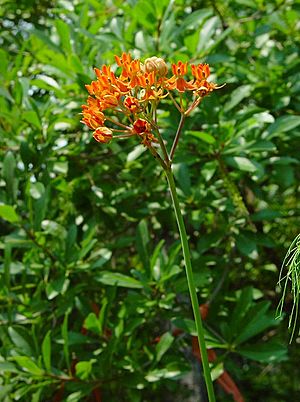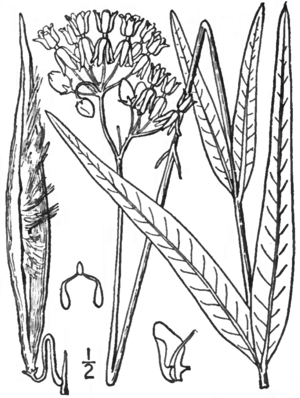Fewflower milkweed facts for kids
Quick facts for kids Fewflower milkweed |
|
|---|---|
 |
|
| Scientific classification | |
| Genus: |
Asclepias
|
| Species: |
lanceolata
|
The Asclepias lanceolata, also known as the fewflower milkweed, is a type of milkweed plant. It grows naturally along the coast of the United States, from New Jersey all the way down to Florida and across to Southeast Texas. This plant stands tall, usually reaching between 3 and 5 feet high. It's a perennial plant, meaning it lives for more than two years. In the summer, you can see its bright red-orange flowers bloom. Sometimes, people call it Cedar Hill milkweed because it was first studied near Cedar Hill in New Haven, Connecticut.
Contents
Where Fewflower Milkweed Grows
Fewflower milkweed is found in the coastal areas of the Eastern and Southeastern United States. You can spot this milkweed in many states, including Alabama, Delaware, Florida, Georgia, Louisiana, Maryland, Mississippi, North Carolina, New Jersey, South Carolina, Tennessee, Texas, and Virginia. It grows widely across most of Florida but only in small parts of southeast Texas. You can even see it growing at the Crosby Arboretum in Picayune, Mississippi.
Home and Environment
Fewflower milkweed is a plant that comes back year after year. It often grows in wet places like marshes (both fresh and salty), open wet areas, and damp pine forests. It likes sandy or loamy soils that drain water well. However, it can also survive in wet, swampy soils that don't drain as easily. The best soil for it is slightly acidic to neutral, but it can grow in a wider range too.
This plant loves sunny spots, though it can also grow in areas with some shade. It's used to getting between 500 to 1500 millimeters of rain each year. It prefers temperatures from 12 to 30 degrees Celsius but can handle a wider range from 8 to 35 degrees Celsius. In winter, this milkweed can survive cold temperatures down to -25 degrees Celsius. In nature, it often grows near another plant called Salt Marsh Mallow. Young fewflower milkweed plants can be damaged by slugs.
What Fewflower Milkweed Looks Like
These plants grow straight up, reaching a height of about 3 to 5 feet. Their leaves grow opposite each other on the stem. They are shaped like a spearhead, getting wider at the base and tapering to a point. Each leaf can be up to 10 centimeters long.
Near the top, the stem branches out. It usually forms 1 to 3 flower clusters, called umbels. Each cluster has about seven red-orange flowers. Most other milkweed plants have many more flowers, which is why this one is called "fewflower milkweed." In the winter, this plant loses all its leaves and becomes hard to notice when it's not flowering.
Flowers, Fruit, and Reproduction
The flowers of Asclepias lanceolata are a bright red-orange color and can be up to 1 centimeter wide. They start blooming in early summer, usually in May and June, and continue through July and August. These flowers have both male and female parts, so they can reproduce. They have five sepals (leaf-like parts under the petals) and five petals. Their shape is symmetrical, like a star.
After the flowers, the plant produces long, thin pods, also called follicles. These pods contain tiny seeds. The seeds become ripe in September. Each seed has small hairs that help the wind carry them far away to new places.
Pollination and Life Cycle
Fewflower milkweed plants can either reproduce with themselves or with other plants of the same type. Pollinators, like bees and other insects, are very important for this plant's life cycle. Butterflies, including monarch, queen, and soldier butterflies, help pollinate this plant. Their caterpillars also eat the leaves of the fewflower milkweed. Adult butterflies and insects also drink nectar from its flowers. Scientists have found that A. lanceolata provides excellent nectar for its helpful pollinators.
Uses of Fewflower Milkweed
While fewflower milkweed is often grown just for its beauty, it has been used for other things too.
As Food
It's important to be careful when thinking about eating milkweed plants. Some types of milkweed can be poisonous to humans. While there are no reports of toxins in Asclepias lanceolata, many milkweeds do contain substances that can be harmful. The flowers, leaves, and young seedpods of this specific milkweed are considered safe to eat.
The seedpods are best eaten when they are about 3 to 4 centimeters long. As they grow larger, they can become more bitter. To remove any possible toxins, especially from stems and older leaves, you should boil the plant parts. It's best to change the water three times during boiling. Younger leaves, pods, and unopened flower buds can be cooked like spinach or broccoli. Once cooked, you can eat them plain or add them to soups. You can also boil down the flower clusters to make a sweet syrup.
For Medicine
The only known medicinal use for A. lanceolata is to treat warts. The milky liquid, called latex, from the stems and leaves has been used to reduce warts. However, this latex should only be used on the skin and never eaten.
For Materials
The latex found in the stems and leaves can also be used to make rubber. In some cases, it has even been used to make chewing gum. However, gum made from this plant might be toxic, so it's not recommended to chew it. The soft, silky fibers from the seeds can be used as stuffing for pillows or toys. When mixed with other materials, these fibers can even be made into cloth. This fiber is also water resistant.


